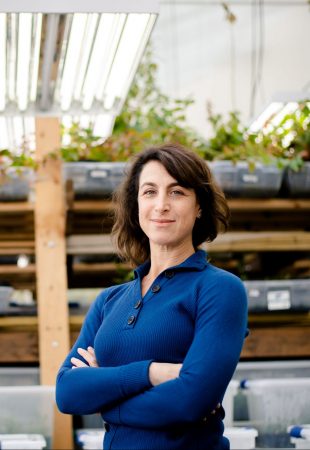Congratulations to Dr. Angela Walczyk (recent Ph.D. from Biological Sciences) and her advisor Dr. Erika Hersch-Green for their two new publications! You can access the papers here:
1. Exciting findings that genome size can affect resource requirements and genomic/transcriptomic functional trait trade-offs.
Abstract
Premise: Increased genome-material costs of N and P atoms inherent to organisms with larger genomes have been proposed to limit growth under nutrient scarcities and to promote growth under nutrient enrichments. Such responsiveness may reflect a nutrient-dependent diploid versus polyploid advantage that could have vast ecological and evolutionary implications, but direct evidence that material costs increase with ploidy level and/or influence cytotype-dependent growth, metabolic, and/or resource-use trade-offs is limited.
Methods: We grew diploid, autotetraploid, and autohexaploid Solidago gigantea plants with one of four ambient or enriched N:P ratios and measured traits related to material costs, primary and secondary metabolism, and resource-use.
Results: Relative to diploids, polyploids invested more N and P into cells, and tetraploids grew more with N enrichments, suggesting that material costs increase with ploidy level. Polyploids also generally exhibited strategies that could minimize material-cost constraints over both long (reduced monoploid genome size) and short (more extreme transcriptome downsizing, reduced photosynthesis rates and terpene concentrations, enhanced N-use efficiencies) evolutionary time periods. Furthermore, polyploids had lower transpiration rates but higher water-use efficiencies than diploids, both of which were more pronounced under nutrient-limiting conditions.
Conclusions: N and P material costs increase with ploidy level, but material-cost constraints might be lessened by resource allocation/investment mechanisms that can also alter ecological dynamics and selection. Our results enhance mechanistic understanding of how global increases in nutrients might provide a release from material-cost constraints in polyploids that could impact ploidy (or genome-size)-specific performances, cytogeographic patterning, and multispecies community structuring.
2. Finding that tetraploid Giant Goldenrods may be pre-adapted to be good invaders but that polyploidy per se does not increase phenotypic plasticity.
Abstract
Polyploidy commonly occurs in invasive species, and phenotypic plasticity (PP, the ability to alter one’s phenotype in different environments) is predicted to be enhanced in polyploids and to contribute to their invasive success. However, empirical support that increased PP is frequent in polyploids and/or confers invasive success is limited. Here, we investigated if polyploids are more pre-adapted to become invasive than diploids via the scaling of trait values and PP with ploidy level, and if post-introduction selection has led to a divergence in trait values and PP responses between native- and non-native cytotypes. We grew diploid, tetraploid (from both native North American and non-native European ranges), and hexaploid Solidago gigantea in pots outside with low, medium, and high soil nitrogen and phosphorus (NP) amendments, and measured traits related to growth, asexual reproduction, physiology, and insects/pathogen resistance. Overall, we found little evidence to suggest that polyploidy and post-introduction selection shaped mean trait and PP responses. When we compared diploids to tetraploids (as their introduction into Europe was more likely than hexaploids) we found that tetraploids had greater pathogen resistance, photosynthetic capacities, and water-use efficiencies and generally performed better under NP enrichments. Furthermore, tetraploids invested more into roots than shoots in low NP and more into shoots than roots in high NP, and this resource strategy is beneficial under variable NP conditions. Lastly, native tetraploids exhibited greater plasticity in biomass accumulation, clonal-ramet production, and water-use efficiency. Cumulatively, tetraploid S. gigantea possesses traits that might have predisposed and enabled them to become successful invaders. Our findings highlight that trait expression and invasive species dynamics are nuanced, while also providing insight into the invasion success and cyto-geographic patterning of S. gigantea that can be broadly applied to other invasive species with polyploid complexes.

